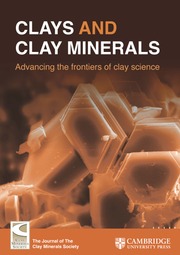Crossref Citations
This article has been cited by the following publications. This list is generated based on data provided by Crossref.
Tomita, Katsutoshi
1978.
Experimental Transformation of 2M Sericite into a Rectorite-Type Mixed-Layer Mineral by Treatment with Various Salts. II. Experiments Using a Magnetic Stirrer and a Centrifuge.
Clays and Clay Minerals,
Vol. 26,
Issue. 3,
p.
209.
Wilson, M. J.
2004.
Weathering of the primary rock-forming minerals: processes, products and rates.
Clay Minerals,
Vol. 39,
Issue. 3,
p.
233.
Kitagawa, Yasuo
2005.
Characteristics of Clay Minerals in Podzols and Podzolic Soils.
Soil Science and Plant Nutrition,
Vol. 51,
Issue. 2,
p.
151.
Morimoto, Kazuya
Tamura, Kenji
and
Sakuma, Hiroshi
2016.
Generation of Second-stage Structure in the Alkylammonium Cation and Potassium Sericite Mica System.
Chemistry Letters,
Vol. 45,
Issue. 3,
p.
336.

